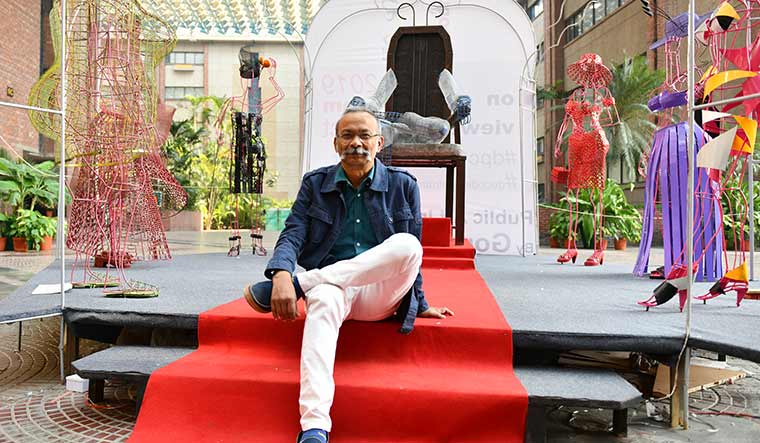If one were to guess how muralist, artist and designer Gopal Namjoshi thinks, he could be doing it by flipping things over or turning them upside down. As a young man in the gallery circuit, struggling to get noticed in group shows in Delhi, Namjoshi understood the hidden significance of frames. “I thought people were, unwittingly, falling for frames. You can put garbage in the name of painting in a pretty-looking frame and people will buy it,” says the 58-year-old Gurgaon-based artist on the sidelines of his show Decoding Patriarchal Codes in Delhi.
So quite early on, he decided to work with murals. Murals need no frames to stand out. And he began to mount his love for abstract acrylic paintings as box-shaped panoramas on the wall; works in mixed-media bonded in resin with found objects thrown in sometimes. His process of creation involved minimum waste. Then one day, an interested viewer politely told him that what he does are not murals but installations. The word stuck. With time his ambitions grew. And before he knew it, Namjoshi was scouting for wider spaces which could hold his outsized installations.
In 2013, Select City Walk, Delhi’s sparkling shopper’s paradise with a penchant for giant floating sculptures, hosted Spring Is In The Air—Namjoshi’s recreation of an 80-feet-long free-standing branch made with shreds of paper and vinyl sheets scrounged from his studio. That was the first crystallisation of his signature style. Now, Namjoshi’s standard operating procedure is carving public art with waste. Only the medium and the message differ.
In the ongoing show—a visual commentary on entrenched patriarchy and gender-based violence—Namjoshi has used scraps of wire mesh, window grills, tree guards, washers, laser-cut metal strips and discarded plumbing pipe from construction sites to create a circle of women dressed in yellow, red, purple and pink. A patriarch without a torso sits on a red-carpet throne. Again, in his typical approach of the flip-side, Namjoshi says, “I don’t think they know, but even men are victims in a patriarchal culture.” His next piece de resistance is a 25-foot replica of a sitting ‘tao’ or a khap panchayat functionary in metal scrap.
Namjoshi was born and raised in Jaipur where he went on to flourish as a design consultant with UNICEF, and helped in development of the prestigious arts centre Jawahar Kala Kendra. But a period of creative stasis prompted him to shift to Delhi and start afresh when he was around 40. Today, while his sculptural musings in junk adorn public institutions and private homes including IIT Delhi, ITEC-Technopark, Nehru Centre in Mumbai, Federation of Indian Export Organisation and cricketer Virat Kohli’s residence, where he made a horse out of kitchen spoons, it is his menagerie in iron and steel at the Taj Gateway Resort, Damdama Lake, off-Gurgaon-Sohna road, that Namjoshi fondly keeps reverting to. A soft, serene picture of rural idyll has been enacted in a luxury hotel with cows, lambs, peacocks, butterflies and buffaloes fashioned out of automobile waste. Think motorcycle gears, chains, shockers, metal sheets, oil filters, petrol tanks and cycle seats.
In Namjoshi’s world, trash is an aesthetic treasure which can square up with real-world environmental challenges. “People don’t have their concepts right. If I make something for tiger conservation, I am not helping save the tiger. I want to say that it is the tiger that saves us,” says Namjoshi.


